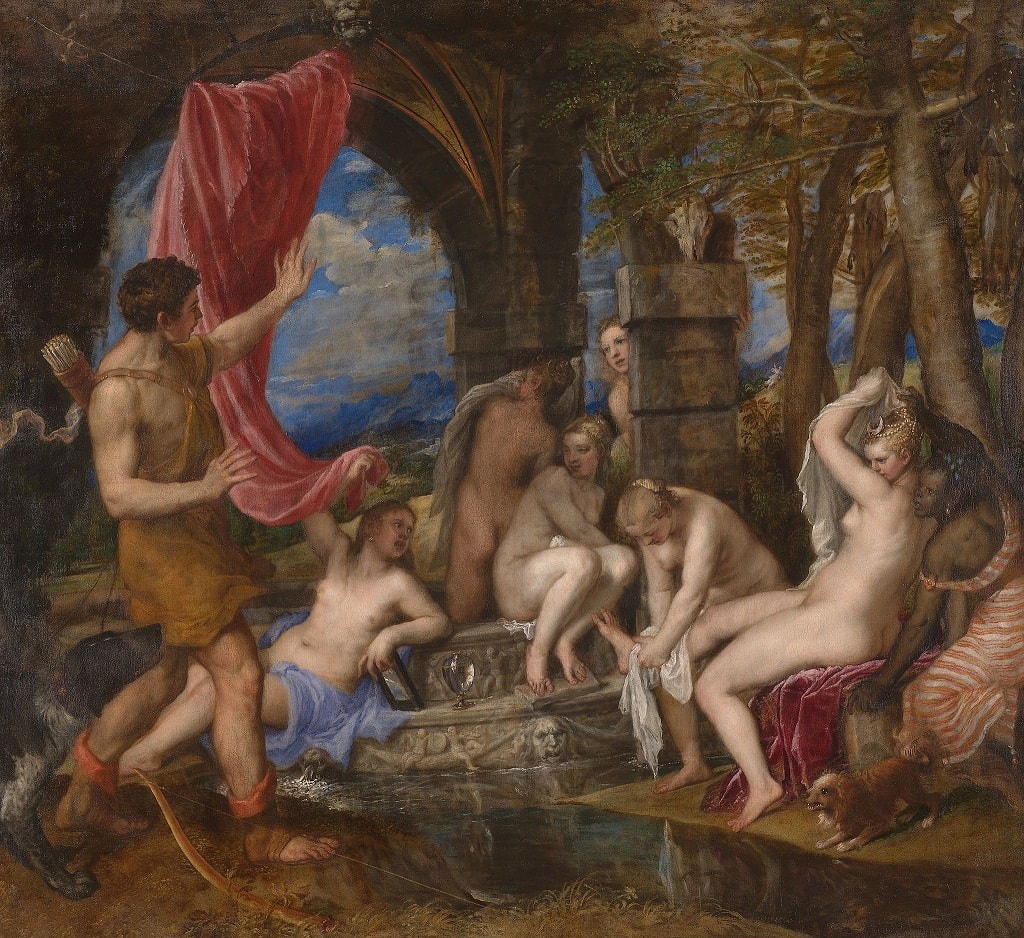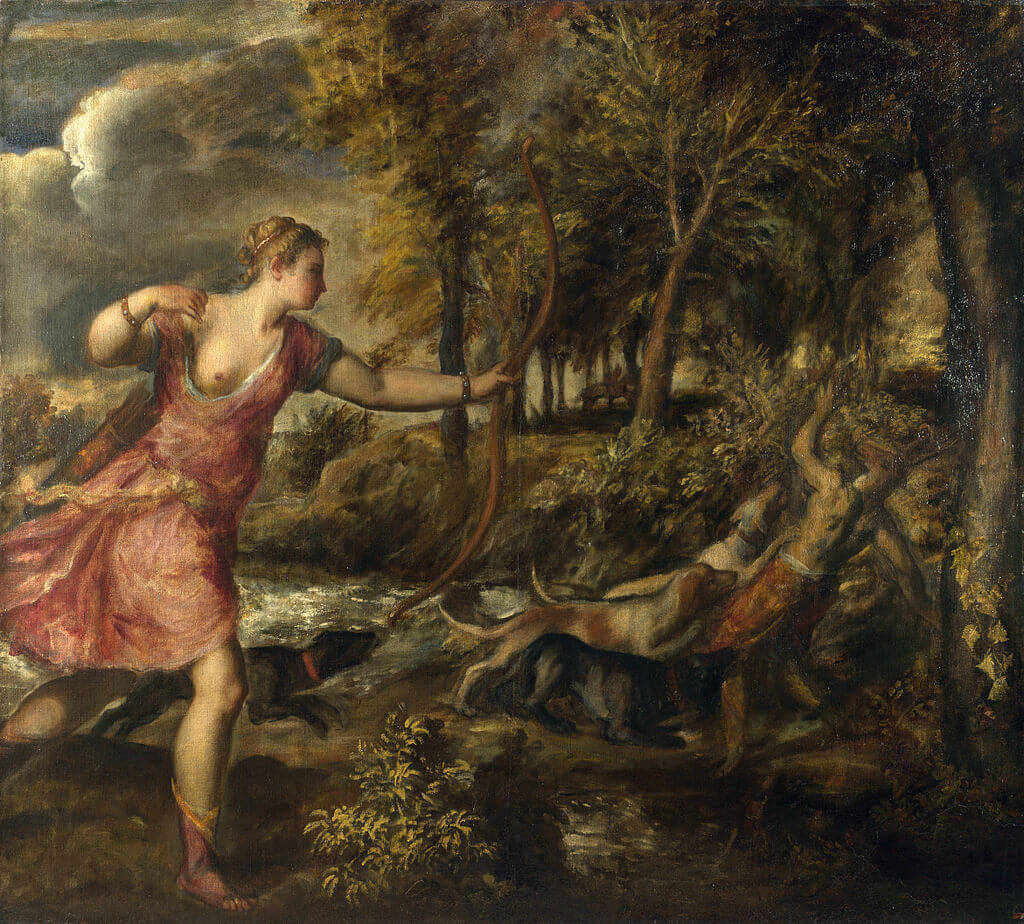|
Where? Room 6 of the National Gallery
When? 1556-1559 Commissioned by? King Philip II of Spain What do you see? On the left, the hunter Actaeon arrives together with his dog to a bathing scene of the goddess Diana and her five nymphs and one slave. Actaeon is wearing his arrows on his back, and his bow fell on the ground. The nymph on the left draws back the curtain to reveal that Actaeon is looking at the naked Diana at the other side of a small stream. She is sitting on the right, next to a fountain, on the red cloth and is washed by one of her nymphs. Diana wears a diadem with a crescent moon. Diana is surprised by the arrival of Actaeon, and the dark-skinned slave behind her helps to cover her identity by putting a cloth in front of her face. Next to Diana, you can see one of her lapdogs who is barking at the dog of Actaeon. Above the knees of Diana, you can see a skull of a deer on top of a pillar, which is part of an arched canopy. To the right of the skull, you can see a deerskin hanging in the tree and to the right of that hangs another deerskin at the edge of the painting. In the background, above Diana, you can see a very small figure of a person dressed in white who is chasing a deer. This person is probably another depiction of Diana while she is hunting. There are various other details in the paintings. For example, in the middle of the painting, you can see a vase and a mirror. You can also see that the water enters the stream through the mouth of one of the carved lion heads below the nymph on the left. Backstory: This painting is part of a series of seven mythological paintings that Titian painted for King Philip II of Spain. Titian entitled this painting as Diana at the Fountain Surprised by Actaeon. Titian based this painting on the third book of the Metamorphosis by Ovid (Amazon link to the book). The story goes: “While Titania is bathing there... Cadmus’s grandson [Actaeon]… strays with aimless steps through the strange wood, and enters the sacred grove… As soon as he reaches the cave mouth dampened by the fountain, the naked nymphs, seeing a man’s face, beat at their breasts and filling the whole wood with their sudden outcry, crowd round Diana to hide her with their bodies... Diana’s face, seen there, while she herself was naked, was the colour of clouds stained by the opposing shafts of sun... She [Diana] caught up a handful of the water that she did have, and threw it in the man’s face... Without more threats, she gave the horns of a mature stag to the head she had sprinkled, lengthening his neck, making his ear-tips pointed, changing feet for hands, long legs for arms, and covering his body with a dappled hide... They [the dogs of Actaeon] surround him on every side, sinking their jaws into his flesh, tearing their master to pieces in the deceptive shape of the deer.” Symbolism: The skull of the stag (a male deer) with antlers refers to the fate that awaits Actaeon. After having seen Diana naked, she changes him into a male deer and was killed by his 50 hounds. The skull and the deer skins also refer to Diana as the goddess of hunting. The diadem with the crescent moon is one of the important attributes of Diana and also refers to her being the goddess of the moon. The top of the dress of the slave is in the form of a crescent moon, which is also a reference to Diana. Who is Diana? Diana (comparable to Artemis in Greek mythology) is the daughter of Jupiter (Zeus in Greek mythology; god of the sky and thunder) and Latona. She was also the twin sister of the God Jupiter. Diana is the goddess of hunting and wild animals. She could communicate with animals. She was also a virgin goddess who promised never to marry a man. Diana’s story has been a popular subject for artists, and she has been painted by, among others, Rubens and Rembrandt. For example, below is the painting Diana and Callisto by Peter Paul Rubens, which is on display in the Prado Museum.
Who is Actaeon? Actaeon was a famous hunter. He was trained by the centaur (half human, half horse) Chiron. He is best known for his cruel death as described above. The reason that Actaeon is killed is either that he claimed to be a better hunter than Diana or because of his sexual interest in her.
After Actaeon was transformed into a stag by Diana, he was killed by his own dogs who did not recognize him anymore. After the dogs killed him, they went back to Chiron to search their master Actaeon as they could not find him. Chiron, who knew what happened, created an image of Actaeon to help them in their grief. Who is Titian? Tiziano Vecelli (or Vecellio) was born around 1489 and died in 1576. He was the most important member of the Venetian School of Painters. He was an all-round painter and was able to paint superb portraits, landscapes, religious and classical paintings. A large number of paintings of Titian have survived of which several can be seen in the National Gallery in London. For example, two other famous paintings of Titian are The Death of Actaeon and Diana and Callisto, which are both also on display in the National Gallery. Just like Diana and Actaeon, these paintings were also a part of the series of seven mythological paintings that Titian created for King Philip II. Another painting in the National Gallery is Bacchus and Ariadne.
Fun fact: This painting is jointly owned by the National Gallery in London and the National Gallery of Scotland. The painting will rotate every five years between both museums. It was bought by both museums, after an extensive public campaign to raise the money, for a sum of $70.6 million. One of the reasons for the high price of this painting is that the painting was well-preserved over time. One exception may be that the deer skins hanging in the trees are hard to see. The reason is that the copper color that was used here changes into brown after extensive exposure to light.
The painting is currently listed in the top 100 of most expensive paintings ever. Two other paintings of Titian are also listed in this top 100. One of those two paintings is Diana and Callisto, which was bought by the National Gallery in London and the National Gallery of Scotland through a similar construction in 2013 for a total of $71.7 million.
Written by Eelco Kappe
References:
0 Comments
Leave a Reply. |
Categories
All
|
- Home
- Blog
-
Museums
- Alte Pinakothek
- Art Institute of Chicago
- Baltimore Museum of Art
- Barber Institute of Fine Arts
- Bargello
- Barnes Foundation
- British Museum
- Church of Sant’Anastasia
- Cleveland Museum of Art
- Courtauld Institute of Art
- Detroit Institute of Arts
- Frans Hals Museum
- Galleria Borghese
- Gallerie dell'Accademia
- Getty Museum
- Guggenheim
- Hermitage Museum
- Kunsthistorisches Museum
- Kunstmuseum Basel
- Legion of Honor Museum
- Louvre
- Mauritshuis
- Metropolitan Museum of Art
- Musee d’Orsay
- Museum of Fine Arts in Boston
- Museum of Modern Art
- National Gallery in London
- National Gallery of Art
- National Museum in Poznań
- Norton Simon Museum
- Ny Carlsberg Glyptotek
- Palace of Versailles
- Palazzo Pitti
- Palazzo Vecchio
- Petit Palais
- Philadelphia Museum of Art
- Prado
- Pushkin Museum
- Ravenna Art Museum
- Rijksmuseum
- San Diego Museum of Art
- Santa Maria delle Grazie
- St. Peter's Basilica
- Städel Museum
- Statens Museum for Kunst
- Tate Britain
- Tate Modern
- Timken Museum of Art
- Uffizi
- Vatican Museums
- Wallace Collection
-
Artists
- Altdorfer
- Anguissola
- Berlin Painter
- Bosch
- Botticelli
- Boucher
- Bronzino
- Bruegel the Elder
- Brunelleschi
- Cabanel
- Caillebotte
- Canova
- Caravaggio
- Carpeaux
- Cezanne
- Cimabue
- David
- Degas
- Delacroix
- De Maria
- Donatello
- El Greco
- Fontana
- Fra Angelico
- Fragonard
- Gauguin
- Gentileschi
- Gericault
- Gonzalez-Torres
- Goya
- Hals
- Hogarth
- Hokusai
- Ingres
- Leonardo da Vinci
- Lippi, Filippo
- Longhi, Barbara
- Lorrain
- Makovsky
- Manet
- Massys
- Matisse
- Merian
- Michelangelo
- Mochi
- Modigliani
- Monet
- Panini
- Parmigianino
- Perugino
- Picasso
- Pisanello
- Raphael
- Rembrandt
- Renoir
- Reynolds
- Rivera
- Rodin
- Rubens
- Scultori
- Seurat
- Steen
- Tintoretto
- Titian
- Toulouse-Lautrec
- Turner
- Uccello
- Van der Weyden
- Van Dyck
- Van Eyck
- Van Gogh
- Van Hemessen
- Vasari
- Velazquez
- Vermeer
- Veronese
- Vigée Le Brun
-
Locations
- Books
- About Us





